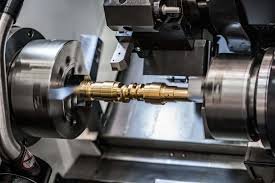In modern manufacturing, precision, speed, and efficiency are everything. Whether you’re developing a new product, replacing parts, or optimizing production, choosing the right machining process can significantly impact your results and costs.
Two commonly used subtractive manufacturing methods are CNC machining services and CNC turning services. Though they are closely related, they are not interchangeable. Each has unique strengths and best-use scenarios.
So, which one is right for your project?
In this guide, we’ll compare CNC machining service and CNC turning services, explore their differences, advantages, and applications—and help you determine the best fit for your needs.
What is CNC Machining Service?
CNC machining service is a broad term that typically refers to CNC milling, where rotating cutting tools remove material from a workpiece that is stationary or moves in various directions. This process can create complex 2D and 3D shapes from metals, plastics, and other materials.
🔧 Key Characteristics:
-
Utilizes rotating cutting tools
-
Ideal for flat or irregular surfaces
-
Multi-axis movement for intricate geometries
-
Can machine slots, holes, and contours
🏗️ Common Applications:
-
Brackets and housings
-
Engine components
-
Enclosures
-
Complex 3D prototypes
If your part requires multiple surfaces, pockets, angles, or complex detailing, a professional CNC machining service is often the preferred choice.
What is CNC Turning Service?
CNC turning, on the other hand, involves rotating the workpiece itself while a cutting tool removes material. It is primarily used to create cylindrical parts or components with rotational symmetry.
🔩 Key Characteristics:
-
The workpiece rotates, not the tool
-
Single-point cutting tool
-
Fast, efficient production of round shapes
-
Typically used with lathes
🧩 Common Applications:
-
Shafts and rods
-
Screws and fasteners
-
Bushings
-
Nozzles and rings
CNC turning is fast, precise, and cost-effective for high-volume runs of symmetrical parts.
CNC Machining vs. CNC Turning: Side-by-Side Comparison
| Feature | CNC Machining Service | CNC Turning Service |
|---|---|---|
| Workpiece Motion | Stationary or linear movement | Rotates during operation |
| Tool Motion | Rotates and moves along multiple axes | Stationary tool moves linearly |
| Best For | Complex geometries, multi-surface parts | Cylindrical parts, high-volume production |
| Precision | Extremely high for detailed cuts | Very high for round parts |
| Setup Time | Moderate | Low |
| Production Speed | Slower for complex parts | Faster for symmetric components |
| Cost Efficiency | Better for low to medium volume | Excellent for high-volume production |
Which One is Best?
There is no one-size-fits-all answer. The best choice depends on the geometry, quantity, material, and functional purpose of your part.
✅ Choose CNC Machining Service When:
-
Your part is complex and multi-faceted
-
You need tight tolerances across several planes
-
The design includes intricate cavities, slots, or angles
-
The part is irregular or non-symmetrical
📌 For advanced milling capabilities and precision multi-axis work, explore this trusted CNC machining service provider offering high-performance solutions tailored to your design needs.
✅ Choose CNC Turning Service When:
-
Your part is round or cylindrical
-
You need a high volume of identical parts
-
The priority is speed and cost-efficiency
-
Surface finish consistency is important
Can You Use Both?
Absolutely. In many manufacturing scenarios, CNC machining and turning are used together. For example, a part may be turned to achieve its initial round shape and then machined to add slots, threads, or side holes.
This combination ensures parts meet complex functional requirements without compromising efficiency or quality.
Material Considerations
Both CNC machining and turning work with a wide range of materials, but your choice might influence which process is better:
-
Aluminum & Plastics: Easily handled by both
-
Steel & Stainless Steel: Ideal for both, but turning may be faster for rods and shafts
-
Titanium: Often needs careful, slow-speed machining
-
Brass & Copper: Highly machinable and suited to both processes
If your material is particularly tough or sensitive, consult your machining partner for process compatibility.
Industries That Use Both Services
-
Aerospace: Precision components requiring both turning and milling
-
Automotive: Engine parts, gears, suspension parts
-
Medical Devices: Surgical tools, implants, connectors
-
Defense & Military: Rugged parts with tight tolerances
-
Consumer Electronics: Housings, connectors, enclosures
The Importance of a Trusted CNC Partner
Whether you need turned parts or milled prototypes, working with a seasoned CNC service provider ensures accuracy, material efficiency, and fast turnaround.
💡 Tip: Choose a shop that offers both CNC machining and CNC turning in-house. This gives you flexibility, consistency, and a single point of quality control.
One such solution is offered by this professional CNC machining service provider, known for delivering precision engineering and expert support at every stage of production.
Final Thoughts
The debate between CNC machining vs. CNC turning isn’t about which is universally better—it’s about which is best for your specific part.
-
Need cylindrical shapes? Go with CNC turning.
-
Have a complex 3D design? CNC machining is your tool of choice.
-
Not sure? A hybrid approach might be perfect.
Understanding the nuances of each process allows designers and engineers to make informed decisions, save time, reduce costs, and ensure their components meet every performance expectation.
Still unsure which service suits your project?
✅ Reach out to the experts at CNC Machining Services for tailored advice, fast quotes, and unmatched precision in metal and plastic manufacturing.
Let me know if you’d like this formatted in HTML for Blogger or Medium, or need a social media promo caption based on this article!






